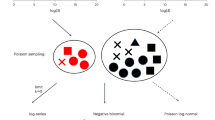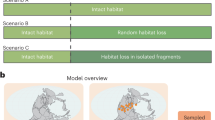Abstract
One of the fundamental questions of ecology is what controls biodiversity. Recent theory suggests that biodiversity is controlled predominantly by neutral drift of species abundances1,2,3,4. This theory has generated considerable controversy5,6,7,8,9,10,11,12, because it claims that many mechanisms that have long been studied by ecologists (such as niches) have little involvement in structuring communities. The theory predicts that the species abundance distribution within a community should follow a zero-sum multinomial distribution (ZSM), but this has not, so far, been rigorously tested. Specifically, it remains to be shown that the ZSM fits the data significantly better than reasonable null models. Here I test whether the ZSM fits several empirical data sets better than the lognormal distribution. It does not. Not only does the ZSM fail to fit empirical data better than the lognormal distribution 95% of the time, it also fails to fit empirical data better even a majority of the time. This means that there is no evidence that the ZSM predicts abundances better than the much more parsimonious null hypothesis.
This is a preview of subscription content, access via your institution
Access options
Subscribe to this journal
Receive 51 print issues and online access
$199.00 per year
only $3.90 per issue
Buy this article
- Purchase on Springer Link
- Instant access to full article PDF
Prices may be subject to local taxes which are calculated during checkout



Similar content being viewed by others
References
Hubbell, S. P. A Unified Theory of Biodiversity and Biogeography (Princeton Univ. Press, Princeton, 2001)
Hubbell, S. P. Tree dispersion, abundance and diversity in a tropical dry forest. Science 203, 1299–1309 (1979)
Hubbell, S. P. & Foster, R. B. in Community Ecology (eds Diamond, J. & Case, T.) 314–328 (Harper & Row, Cambridge, Massachusetts, 1975)
Bell, G. Neutral macroecology. Science 293, 2413–2418 (2001)
de Mazancourt, C. Consequences of community drift. Science 293, 1772 (2001)
Enquist, B. J., Sanderson, J. & Weiser, M. D. Modeling macroscopic patterns in ecology. Science 295, 1835–1837 (2002)
Levine, J. M. Species diversity and relative abundance in metacommunities. Trends Ecol. Evol. 17, 99–100 (2002)
Abrams, P. A. A world without competition. Nature 412, 858–859 (2001)
Clark, A. Macroecology comes of age. Trends Ecol. Evol. 17, 352–353 (2002)
Condit, R. et al. Beta-diversity in tropical forest trees. Science 295, 666–669 (2002)
Terborgh, J., Foster, R. B. & Nunez, P. V. Tropical tree communities: a test of the nonequilibrium hypothesis. Ecology 77, 561–567 (1996)
Yu, D. W., Terborgh, J. & Potts, M. D. Can high tree species richness be explained by Hubbell's null model? Ecol. Lett. 1, 193–199 (1998)
Price, J., Droege, S. & Price, A. The Summer Atlas of North American Birds (Academic, San Diego, 1995)
Robbins, C. S., Bystrak, D. & Geissler, P. H. The Breeding Bird Survey: Its First Fifteen Years, 1965–1979 (US Department of the Interior, Fish and Wildlife Service, Washington DC, 1986)
Sauer, J. R., Hines, J. E. & Fallon, J. The North American Breeding Bird Survey, Results and Analysis 1966–2000 Version 2001.2 (USGS, Patuxent Wildlife Research Center, Laurel, Maryland, 2001); available at 〈ftp://pwrcftpr.er.usgs.gov/mp/bbs/DataFiles/〉
Pyke, C. R., Condit, R., Aguilar, S. & Lao, S. Floristic composition across a climatic gradient in a neotropical lowland forest. J. Veg. Sci. 12, 553–566 (2001)
Burslem, D., Whitmore, T. & Brown, G. Short-term effects of cyclone impact and long-term recovery of tropical rain forest on Kolombangara, Solomon Islands. J. Ecol. 88, 1063–1078 (2000)
Laurance, W., Ferreira, L., Rankin-De Merona, J. & Laurance, S. Rain forest fragmentation and the dynamics of Amazonian tree communities. Ecology 79, 2032–2040 (1998)
Gaston, K. J. & Blackburn, T. M. Pattern and Process in Macroecology (Blackwell Science, Oxford, UK, 2000)
Tokeshi, M. Species abundance patterns and community structure. Adv. Ecol. Res. 24, 111–186 (1993)
Pielou, E. C. Mathematical Ecology (John Wiley & Sons, New York, 1977)
Harte, J., Kinzig, A. P. & Green, J. Self-similarity in the distribution and abundance of species. Science 284, 334–336 (1999)
Dewdney, A. K. A dynamical model of communities and a new species-abundance distribution. Biol. Bull. 198, 152–165 (2000)
Kimura, M. The Neutral Theory of Molecular Evolution (Cambridge Univ. Press, Cambridge, UK, 1983)
McGill, B. J. Strong and weak tests of macroecological theory. Oikos (in the press)
Grimmett, G. R. & Stirzaker, D. R. Probability and Random Processes (Clarendon, Oxford, UK, 1992)
May, R. M. in Ecology and Evolution of Communities (eds Cody, M. L. & Diamond, J. M.) 81–120 (Belknap, Harvard Univ. Press, Cambridge, Massachusetts, 1975)
Hilborn, R. & Mangel, M. The Ecological Detective: Confronting Models with Data (eds Levin, S. A. & Horn, H. S.) (Princeton Univ. Press, Princeton, New Jersey, 1997)
Acknowledgements
I thank the numerous volunteers who spent many hours collecting the BBS data, and the professionals at Patuxent Wildlife Research Center, who have put the data into an accessible, high-quality format, as well as those who collected and published the enormously valuable BCI data set. I also thank M. Rosenzweig, B. Enquist and the students in their laboratories for stimulating my thinking in this area. The National Science Foundation provided funding for this research. B. Walsh was a useful sounding board on statistics. Finally, I thank S. Marx, M. Weiser, D. Faulk and W. Turner for suggestions on an earlier draft of this paper, especially M. Weiser for his clarity on the importance of stopping rules, and S. Marx for greatly increasing the clarity of the paper.
Author information
Authors and Affiliations
Corresponding author
Ethics declarations
Competing interests
The author declares that he has no competing financial interests.
Supplementary information
Rights and permissions
About this article
Cite this article
McGill, B. A test of the unified neutral theory of biodiversity. Nature 422, 881–885 (2003). https://doi.org/10.1038/nature01583
Received:
Accepted:
Published:
Issue Date:
DOI: https://doi.org/10.1038/nature01583
This article is cited by
-
Taxonomic dependency and spatial heterogeneity in assembly mechanisms of bacteria across complex coastal waters
Ecological Processes (2024)
-
Neutral and niche theory in community ecology: a framework for comparing model realism
Biology & Philosophy (2024)
-
Unveiling global species abundance distributions
Nature Ecology & Evolution (2023)
-
Bayesian two-part modeling of phytoplankton biomass and occurrence
Hydrobiologia (2022)
-
Niche partitioning among dead wood-dependent beetles
Scientific Reports (2021)
Comments
By submitting a comment you agree to abide by our Terms and Community Guidelines. If you find something abusive or that does not comply with our terms or guidelines please flag it as inappropriate.



